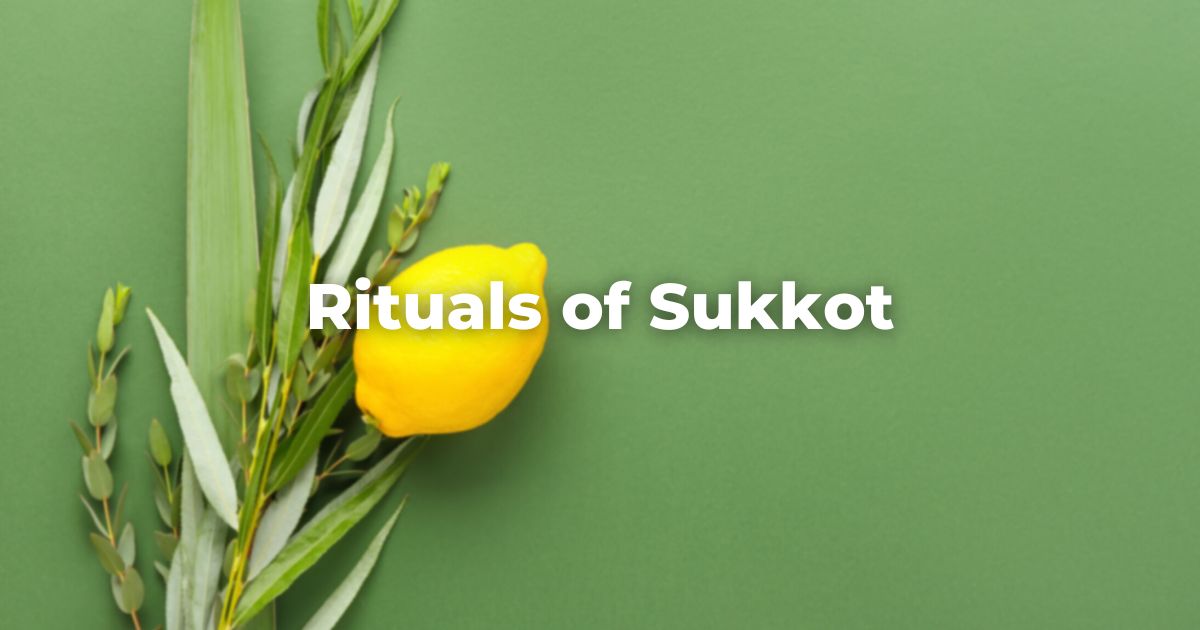Five days after Yom Kippur, we celebrate Sukkot, one of the shalosh regalim, the three so-called pilgrimage festivals.
Harvesting and Pilgrimaging
While each of these holidays has a specific historical framework, a unique spiritual theme, and an individual agricultural aspect, they all celebrate the bounty of the land.
Sukkot, however, is the quintessential harvest festival. Furthermore, its annual commemoration of the wandering of the Jewish people in the wilderness on their way to the Promised Land leads worshipers to a profound and inspiring spiritual lesson: that one of the most effective paths an individual can follow to faith in God is the one along which the fragility and ephemeral nature of life are taken truly to heart and allowed to energize and inspire the human spirit.
American readers will also enjoy thinking of Sukkot as the original Thanksgiving and as the historical model that inspired the Pilgrims.
Mitzvot
There are two specific mitzvot observed solely during Sukkot that serve as its most potent symbols: the sukkah (a booth or hut) and the arba·ah minim, the “four species” or “four kinds,” more popularly known as the lulav and etrog (the former of which is combined with two other “species,” as described here).
What the Week Looks Like
Sukkot begins on the fifteenth of Tishrei and continues for seven days. In Israel, only the first day of Sukkot is a full festival day and the remaining days are Ḥol Ha-mo·eid, additional days that are awarded a kind of semi-holiday status.
This accords with the simple meaning of the biblical text at Leviticus 23:35, “The first day shall be a sacred occasion.” In the Diaspora, however, the second day is considered a festival day as well and is called: yom tov sheini shel galuyot, “the second festival day of the Diaspora.”
This much-maligned practice of an extra festival day deserves an explanation.
In ancient times, the holy days were not set by a fixed calendar, but were rather determined based on careful observation of the lunar cycle.
In an elaborate system of notification honed over the generations, witnesses would come before a religious court and testify that the new moon had been sighted and then, through a system of messengers and bonfires, the word was spread near and far (M Rosh Ha-shanah 2:2–5).
This system was obviously predicated on the assumption that the entire Jewish population of the world could be reached efficiently by messengers traveling on foot or carried forward by animals, but this stopped being the case early in Jewish history.
To make absolutely sure, then, that the “correct” day was never missed, the rabbis of the Diaspora established a two-day festival. Surely one of the days would be the right one!
With the establishment of the calendar we now use, however, it became possible to fix the date of each holiday exactly, thereby rendering the doubling of the festivals theoretically unnecessary.
Yet, when the issue came before the rabbis even in talmudic times, they refused to cancel what had already been put in place, saying, either regretfully or proudly—there’s no clear way to know—minhag avoteinu b’yadeinu, the custom of our ancestors is inviolate and cannot be set aside by changing circumstance (BT Beitzah 4b).
Of course, that is not invariably how things are.
Some ancient customs rooted in realities that have long since ceased to exist have indeed been allowed to fall into desuetude, and there is a responsum of the Rabbinical Assembly’s Committee on Jewish Law and Standard permitting communities who so desire to observe only one day of the pilgrimage festivals.
[This responsum can be found here: David Golinkin, Editor. 1997 Proceedings of the Jewish Law and Standards Committee of the Conservative Movement 1927 – 1970, Volume Three: Responsa. Pages 1228-1272 (Yom Tov Sheni Shel Goluyot by Aaron H. Blumenthal + Responsa)]
This innovative leniency has not gained much popularity in Conservative congregations, however, and, while some congregations observe only one day, most communities continue to observe the two days of each festival outside of Israel as a way of preserving one of the most traditional distinctions between life in the Holy Land and life in the Diaspora.
Ritual and Liturgy
With respect to ritual and liturgy, the laws and customs for the second day are the same as those that govern the first, including the recitation of She-heḥeyyanu (also written as shehechianu) on the second night when lighting the candles and when saying Kiddush.
Sh’mini Atzeret
Sukkot ends with a festival that is both part of it yet also distinct.
Its name, Sh’mini Atzeret (“The Eighth Day of Assembly”), points to its connection with Sukkot. Yet the halakhah treats it as a separate and distinct festival in many contexts, including, for example, the laws that govern mourning.
In the Diaspora, Sh’mini Atzeret is observed for two days, but the second day has its own name: Simḥat Torah. Also, each of these days has its own rituals and liturgy. In Israel, the rituals and liturgical flourishes connected with both Sh’mini Atzeret and Simḥat TorahRefers to the first five books of the Hebrew Bible, the Tanakh, also called the Five Books of Moses, Pentateuch or the Hebrew equivalent, Humash. This is also called the Written Torah. The term may also refer to teachings that expound on Jewish tradition. Read more are observed on the same day.
History of Sukkot
The historical aspect of Sukkot is emphasized by the Bible itself: “You shall live in sukkot (booths) for seven days. Indeed, all citizens of Israel shall live in sukkot, in order that future generations may know that I caused the Israelite people to live in sukkot when I brought them out of the land of Egypt” (Leviticus 23:42–43).
But the Bible also speaks of the holiday in agricultural terms, as at Leviticus 23:39: “On the fifteenth day of the seventh month when you have gathered in the yield of your land, you shall observe the festival of the Eternal for seven days.”
The symbols of the festival are rooted mostly in one of these two conceptions.
Sukkah
The sukkah, the temporary hut we erect to remind ourselves of the way our ancestors lived and traveled during their years in the wilderness, adds a historical aspect to the holiday, while the mitzvah of taking up the arba·ah minim emphasizes the agricultural dimension of the festival.
See more explanation behind the sukkah here.
Names of Sukkot
It is not surprising, therefore, that this multi-dimensional holiday has several different names, each focusing on a different aspect of its observance or background.
The name ḥag ha-sukkot, the most familiar, means literally “the holiday of the sukkot [booths].” The name ḥag ha-asif (“the harvest festival”) refers to the agricultural aspect of the holiday. And, as the rabbis considered Sukkot to be the quintessential festival, they referred to it simply as the he-ḥag (“the festival”), with no further qualification.
Sukkot is thus a very happy holiday—also known as z’man simḥateinu, the time of our rejoicing—and its contrast with the preceding High Holidays could not be more dramatic. The High Holidays are spent mostly indoors and are devoted to prayer and deep, introspective contemplation.
The High Holidays Versus Sukkot
Sukkot, on the other hand, is spent mostly outdoors and is devoted to different kinds of celebration and rejoicing. Rosh Hashanah and Yom Kippur are very cerebral festival days, but Sukkot has a far more physical feel to it.
The High Holidays engage the mind, but Sukkot engages the body as well, as we build our sukkot, climb up ladders to put the special roofs in place, and wave and shake our lulavim during the synagogue service.
As mentioned above, one tradition (cf. the gloss of the Rema to SA Oraḥ Ḥayyim 625:1) teaches that the building of the sukkah should begin right after Yom Kippur, and some go so far as to suggest that the first nails should be hammered into the sukkah immediately after the end of the fast!
Clearly tradition understands the two festivals, Yom Kippur and Sukkot, as ends of a single continuum and, in turn, this is intended to remind the faithful that Yom Kippur could not exist without Sukkot: the world of intellectual and spiritual pursuits cannot be separated from the world of physical and bodily endeavor and, at least in the end, one without the other can never feel totally right or lead to spiritual wholeness.
Find information on Sukkot candle lighting here.
Adapted with permission from The Observant Life.
Authors
-

-



The Observant Life: The Wisdom of Conservative Judaism for Contemporary Jews distills a century of thoughtful inquiry into the most profound of all Jewish questions: how to suffuse life with timeless values, how to remain loyal to the covenant that binds the Jewish people and the God of Israel, and how to embrace the law while retaining an abiding sense of fidelity to one’s own moral path in life. Written in a multiplicity of voices inspired by a common vision, the authors of The Observant Life explain what it means in the ultimate sense to live a Jewish life, and to live it honestly, morally, and purposefully. The work is a comprehensive guide to life in the 21st Century. Chapters on Jewish rituals including prayer, holiday, life cycle events and Jewish ethics such as citizenship, slander, taxes, wills, the courts, the work place and so much more.
View all posts





